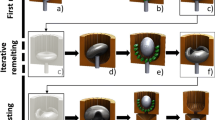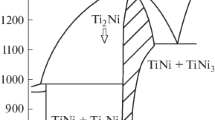Abstract
The study of the mechanical properties of materials based on titanium nickelide arising during thermoelastic martensitic transformations, including reactive stresses, is of great interest. The effect of generating reactive stresses in shape memory materials has an impact on various fields of technology. So, in materials with a shape-memory effect acting as mechanical energy converters and as power elements of drives, conditions are used under which deformation is fixed. This use assumes the stability of properties and operating parameters in this type of device. In this work, reactive stresses that arise in samples of alloys based on titanium nickelide when the strain is fixed, which prevents the shape-memory effect from occurring during the cycling of martensitic transformations, were studied. It is assumed that the cycling of martensitic transformations can lead to a change in reactive stresses due to the structural rearrangement of the material, which, in turn, will affect the performance of units and assemblies made of alloys based on titanium nickelide. It is shown that the level of reactive stresses developed in the sample in the heating–cooling cycle decreases in subsequent cycles. The observed hardening from cycle to cycle, under the action of reactive stresses, can characterize the phenomenon of phase hardening.



Similar content being viewed by others
REFERENCES
D. E. Gusev, M. Yu. Kollerov, A. A. Sharonov, and S. I. Gurtovoi, Titan, No. 1, 42 (2015).
A. S. Gryaznov, V. A. Plotnikov, and S. V. Makarov, Vysokoproizv. Vychisl. Sist. Tekhnol. 3 (1), 138 (2019).
M. I. Soldatova, V. N. Khodorenko, and V. E. Gyunter, Izv. TPU 322, 135 (2013).
V. E. Gyunter, Shape Memory Effects and Their Application in Medicine (Nauka, Novosibirsk, 1992) [in Russian].
V. A. Plotnikov, L. A. Monasevich, and Yu. I. Paskal’, Fiz. Met. Metalloved. 61, 769 (1986).
V. A. Plotnikov and A. S. Gryaznov, State Registration Certificate of Computer Program No. 2008612034, 2008610809 (2008).
ADC Data Logger—dotScope Opensource Project. https://sf.net/p/dotscope/.
V. A. Plotnikov and A. S. Gryaznov, Materialovedenie, No. 3, 2 (2009).
V. E. Gyunter, V. N. Khodorenko, T. L. Chekalkin, et al., in Medical Materials and Shape Memory Implants, Ed. by V. E. Gyunter (MITs, Tomsk, 2011), Vol. 1 [in Russian].
S. A. Belyaev, A. E. Volkov, V. A. Ermolaev, Z. P. Kamentseva, S. L. Kuz’min, V. A. Likhachev, and R. Yu. Khairov, Materials with Shape Memory Effects (SPb. Univ., St. Peterburg, 1998), Vol. 2 [in Russian].
S. A. Egorov, Tech. Phys. 51, 999 (2006).
V. N. Khachin, V. G. Pushin, and V. V. Kondrat’ev, Titanium Nickelide: Structure and Properties (Nauka, Moscow, 1992) [in Russian].
Author information
Authors and Affiliations
Corresponding authors
Ethics declarations
The authors declare that they have no conflicts of interest.
Additional information
Translated by M. Drozdova
Rights and permissions
About this article
Cite this article
Plotnikov, V.A., Guseva, A.V. & Gryaznov, A.S. A Study of Reactive Stresses in Ti50Ni40Cu10 Alloy. Tech. Phys. Lett. 48, 210–213 (2022). https://doi.org/10.1134/S1063785022070069
Received:
Revised:
Accepted:
Published:
Issue Date:
DOI: https://doi.org/10.1134/S1063785022070069




